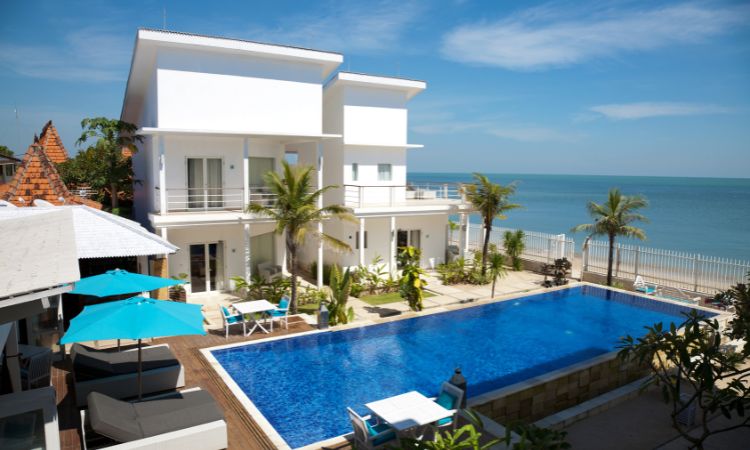Choosing the right living arrangement is crucial for your day-to-day comfort and long-term finances. Understanding the differences between living alternatives, such as villas and apartments, can help you make an informed decision. Independent villas typically offer more space, privacy, and exclusive amenities like private pools and gardens. They are ideal for those seeking peace, outdoor living, and larger areas.
In contrast, apartments often come with shared amenities and require less maintenance, making them suitable for busy professionals or smaller families. This blog will explain the differences between villas and apartments, highlighting their unique features and the pros and cons of each. By the end, you’ll have a clearer understanding of which housing option best suits your needs, lifestyle, and long-term goals.
What are villas?

Villas are spacious homes that stand alone, not connected to other houses. They offer a lot of freedom and privacy because they are usually single-family homes with plenty of room inside. This makes them great for different kinds of lifestyles and needs.
One of the best things about villas is that they often come with private gardens, patios, or even pools. These private spaces are perfect for relaxing or having fun with friends and family. Because villas are separate from other homes, you can personalize them more easily to fit your own style and preferences. This makes villas a peaceful choice for people who enjoy their own space.
You can find villas in various sizes and designs, from ones with big gardens for gardening enthusiasts to ones with pools for families to enjoy together. Villas give you lots of options to find the perfect home that suits your lifestyle and makes you feel comfortable.
What are Apartments?

Apartments are homes located within multi-unit buildings, where each unit is a separate residential space. Unlike villas, apartments share walls, ceilings, and floors with neighboring units. This close proximity often fosters a sense of community among residents while still providing individual living spaces.
Apartments are designed to be efficient and functional, catering to the needs of residents within a compact living environment. They offer various layouts and sizes, accommodating different household sizes and lifestyles.
Living in an apartment means being part of a community where amenities such as parking spaces, common areas, and sometimes facilities like gyms or pools are shared among residents. This communal living setup can be convenient and cost-effective, making apartments a popular choice for urban dwellers and those seeking a centrally located living space.
Also Read: Difference Between Flat and Apartment
Key Differences Between Villas and Apartments
Here are the differences you would need to know about Villa vs. apartment now.
Comparison of Villas and Apartments
| Criteria | Villa | Apartment |
|---|---|---|
| Size and Layout | Villas are more spacious with larger designs. | Apartments maximize available space with suitable layouts for singles, couples, or small families. |
| Indoor and Outdoor Space | Villas provide private rest areas, gardens, patios, or decks for personal use. | Apartments offer shared roof gardens or patios, not owned by one unit alone. |
| Privacy Level | High privacy, no shared walls or floVillas offer high privacy, sharing no walls or floors with neighbors. | Share walls, floors, and ceilings, increasing noise levels Apartments share walls, floors, and ceilings, increasing noise levels and reducing privacy. |
| Ownership Structure | Owners have full ownership of both the house and the land, offering control and value enhancement. | Apartments often have shared ownership of the building, with individual units owned by residents. |
| Common Amenities | May have private pools, gyms, and the ability to landscape and design their own patios. | Offer shared amenities like swimming pools, gyms, laundry rooms, communal spaces, and butler services. |
| Shared vs. Private Facilities | Share services with fewer people, offering more privacy. | Facilities are shared among many tenants, potentially leading to congestion. |
| Type of Community Living | Emphasize independence and seclusion, suitable for quieter living. | Foster social interactions and community living due to proximity and shared spaces. |
| Lifestyle and Social Interaction | Enjoy peace, privacy, and outdoor activities, with limited neighbor interaction. | Engage more with neighbors and participate in community activities due to shared facilities. |
Pros and Cons of Living in a Villa
So, now let us take a look at the Pros and cons of living in a villa that will help you choose.
Advantages:
- Space and Privacy: Villas allow additional space and privacy for families, party hosts, and other users. Larger floor plans offer more choices with more bedrooms, baths, and living spaces. This solitude is derived from the isolation of the villas. It keeps neighbours quiet and serene.
- Customisation and Personalisation: Villa owners are allowed further personalisation of their homes. This may require major interior renovations for landscaping, swimming pools, and outdoor ovens. There is a greater sense of control for the residents and the potential to personalise the home.
Disadvantages:
- Maintenance and Upkeep: Landscaping and the exterior are the villa owners’ concerns. This includes yard work, repairs, and cleaning on the exterior that are necessary for the health and value of the property but come at an expense in terms of time and money.
- Cost Factors: Villas are more expensive to buy and maintain than flats. The base price goes up with size, privacy, and customization. One pays less in property taxes, utilities, and upkeep compared with an apartment house.
- Location and Accessibility: Villas are usually found in rural places, so it takes more time to get to work, school, or other facilities compared to living in an apartment in the city center. These quiet and spacious locations may be harder to reach than cities, making the daily commutes to work and other important services not so easy.
- Less Privacy: You share the walls, floors, and sometimes the ceilings with apartment neighbours, which may make it seem like a noisy place with little privacy. Because it lies close to neighbouring apartments, one can easily hear music, discussions, or housework. The house can be noisier.
Pros and Cons of Living in an Apartment
There are Pros and cons of living in an apartment that may likely affect your lifestyle and home pleasure. When purchasing an apartment, you have to consider convenience, neighbourhood services, privacy, and space
Advantages:
- Convenience and location: Flats offer their residents great convenience. Apartments are close to shopping, restaurants, transit, and entertainment in both cities and suburbs. Residents choose flats in a city because they are located near everything one might need, save on commuting hours, and simplify life.
- Fewer Maintenance Responsibilities: An apartment requires much easier maintenance compared to a home. Property management or the owners take care of building cleaning, exterior repairs, and gardening. The agreements handle upkeep, letting one as a renter focus on various other tasks.
Disadvantages:
- Limited privacy: Private space is the essential key to living in a flat. Shared walls, floors, and ceilings let you hear and see what others are up to. If you happen to live in a crowded flat or in flats with thin walls, you may feel tightly constricted and awkward.
- Space Constraints: In comparison to apartments, single-family houses are way more spacious. Compact bedrooms, kitchen, and living spaces imply there is little storage and space. This will be tough for families or people who need more spaces as options for hobbies, home offices, or storage.
Also Read: Apartment vs. Independent House: Which Offers the Best Lifestyle?

Factors to Consider When Choosing Between a Villa and an Apartment
Budget:
Cost Implications: Villas are costlier and need more care compared to flats. One of the reasons could be that a villa is more expensive because of its size, excellent level of privacy, and extra facilities offered. In addition, maintaining, gardening, utilities, and property tax add to the list. All these calculations of affordability in the long run must be considered before one decides on purchasing.
Finance options: Finance flats and residences in different ways. Houses cost more, so loans may require higher down payments and interest rates. Compare the loan alternatives, interest rates, and conditions of the mortgage to find the best way to own your dream home. Consult a financial counsellor or mortgage professional; he can explain the numbers and chalk out the best price.
Lifestyle preferences:
Family Life and Needs: Depending on the family’s needs, one can choose a house or apartment. For example, villas would more likely be suited to families who require space, beds, and isolation. Any person who likes to be alone, like parents, can opt for them. Small families and young couples looking for ease and little maintenance with all city amenities can choose flats.
Fun and social: Think about friends and activities. Want to be in a close group or have some alone time? Common areas, shared facilities, and closeness to neighbours make apartments friendlier and therefore easier to socialise and arrange community events and activities. Villas have private outdoor space and stand isolated from other buildings to provide privacy. These are more suited to more serene, independent people.
Long-term goals:
Financial Potential: Consider long-term finances while buying a house or apartment. In terms of price, villas with their private acreage, size, and customisation can prove to be valuable in the long term. Improvements done to a home could increase in value if the market changes. This could turn into a very great investment. To the extent that apartments are expedient, low maintenance is required, but, compared to residences, they may appreciate more slowly because of shared ownership and less control over repairs and improvements.
Flexible, with an eye on plans for the future: Think lifestyle and personal dreams. Villas are ideal for a growing family, telecommuters, and those who require a bit of space. Being able to adapt and modify a home means one can enjoy it a little longer and continue to meet needs as they evolve. Apartments grant freedom to pairs if their lives change or when a career requires moving. Apartments are easy to care for and share common utilities because they are habitable for all years and ways of living.
Conclusion
In Choosing between a villa and an apartment, do you want the expansive living, privacy, and outdoor space that villas allow for? Perhaps apartment convenience combined with friendship and sharing amenities would suit your style better. Your goals and taste are what’s going to make you go for one over the other. Think about this in terms of a balanced consideration of salary, family, your social life, and location. This tip is good, but a reliable real estate agent may be more desirable.
Omaxe is one of the top developers in India, featuring modern flats and luxury mansions. Knowing the key differences between these homes will enable a smart decision regarding which one fits your needs best. If you are investing in properties in India contact us today!


